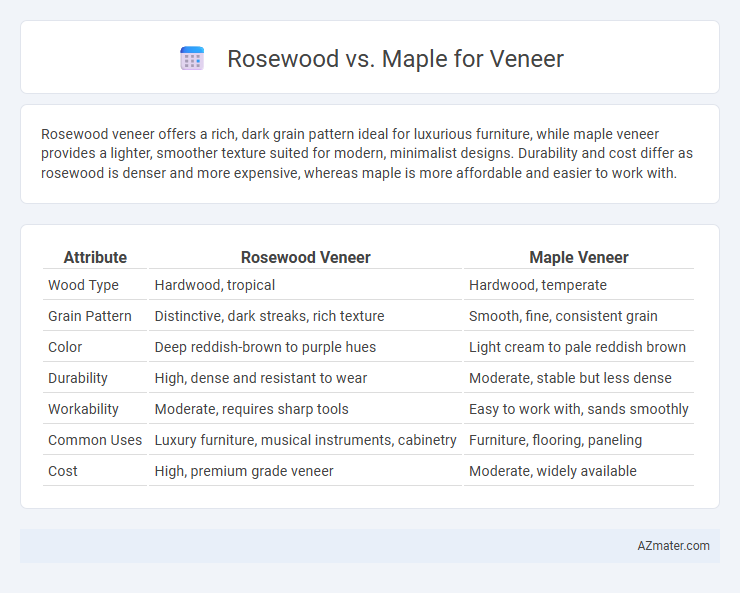Rosewood veneer offers a rich, dark grain pattern ideal for luxurious furniture, while maple veneer provides a lighter, smoother texture suited for modern, minimalist designs. Durability and cost differ as rosewood is denser and more expensive, whereas maple is more affordable and easier to work with.
Table of Comparison
| Attribute | Rosewood Veneer | Maple Veneer |
|---|---|---|
| Wood Type | Hardwood, tropical | Hardwood, temperate |
| Grain Pattern | Distinctive, dark streaks, rich texture | Smooth, fine, consistent grain |
| Color | Deep reddish-brown to purple hues | Light cream to pale reddish brown |
| Durability | High, dense and resistant to wear | Moderate, stable but less dense |
| Workability | Moderate, requires sharp tools | Easy to work with, sands smoothly |
| Common Uses | Luxury furniture, musical instruments, cabinetry | Furniture, flooring, paneling |
| Cost | High, premium grade veneer | Moderate, widely available |
Introduction to Rosewood and Maple Veneer
Rosewood veneer is prized for its rich, dark hues and distinctive grain patterns, offering a luxurious and exotic appearance ideal for high-end furniture and cabinetry. Maple veneer features a lighter color palette with subtle, uniform grain, providing a clean and modern aesthetic that enhances brightness in interior design. Both veneers are durable and versatile, but rosewood is typically favored for its dramatic visual impact, while maple is chosen for its understated elegance and adaptability.
Botanical Origins and Species Differences
Rosewood veneer, derived primarily from Dalbergia species native to tropical regions of South America, Africa, and Asia, is prized for its rich, dark reddish-brown hues and complex grain patterns. Maple veneer originates from Acer species commonly found in North America, known for its lighter, creamy color and smooth, consistent grain texture. The botanical differences between Dalbergia and Acer species result in Rosewood's denser, oilier composition compared to Maple's harder yet less oily surface, influencing their durability and finish quality in wood veneer applications.
Appearance and Color Variations
Rosewood veneer showcases rich, deep hues ranging from dark brown to purplish-black with striking grain patterns that add a dramatic, luxurious appeal. Maple veneer offers a lighter palette, typically creamy white to light reddish-brown, with subtle, uniform grain that creates a clean and modern look. Both woods provide distinct aesthetic qualities: rosewood's bold contrast and exotic patterns versus maple's smooth, consistent texture and brightness.
Grain Patterns and Aesthetic Appeal
Rosewood veneer features rich, dark grain patterns with striking, irregular swirls and deep chocolate to reddish-brown hues, offering a luxurious and exotic aesthetic ideal for high-end furniture. Maple veneer showcases a lighter color palette with smooth, uniform grain patterns and subtle birdseye or curly figures, providing a clean, modern, and versatile look. The choice between rosewood and maple veneers largely depends on the desired visual impact, with rosewood emphasizing bold, dramatic textures and maple delivering refined, understated elegance.
Durability and Hardness Comparison
Rosewood veneer offers superior hardness, typically ranging from 2,440 to 2,700 on the Janka hardness scale, making it highly durable and resistant to dents and scratches, ideal for high-traffic furniture surfaces. Maple veneer, with a Janka hardness of approximately 1,450, is moderately hard and durable, suitable for everyday use but less resistant to heavy impact compared to rosewood. In terms of long-term wear and structural resilience, rosewood's dense grain structure provides enhanced protection against moisture and physical damage, whereas maple requires more careful maintenance to preserve its appearance and integrity.
Workability and Installation Considerations
Rosewood veneer offers excellent workability with its dense grain, allowing for precise cutting and a smooth finish, though it may require sharp blades to avoid chipping. Maple veneer is easier to work with due to its uniform texture and hardness, providing stable installation and less risk of splintering during handling. Installation considerations for rosewood include extra care to prevent cracking, while maple veneer demands minimal adjustment and faster fitting on substrates.
Cost and Availability
Rosewood veneer typically commands a higher cost due to its rarity and exotic appeal, making it less accessible for large projects or budget-conscious buyers. Maple veneer, on the other hand, is more widely available and affordable, benefiting from abundant supplies and faster tree growth. Choosing between the two often depends on balancing the premium price of rosewood's distinctive grain against the economic practicality and consistent availability of maple veneer.
Environmental Impact and Sustainability
Rosewood veneer often raises environmental concerns due to the overharvesting of endangered species and strict regulations under CITES, which affect its sustainability. Maple veneer, sourced from fast-growing and widely available trees, presents a more sustainable option with a lower environmental footprint and better forest management practices. Choosing maple veneer supports responsible forestry and reduces ecological damage compared to the limited and high-demand rosewood resources.
Ideal Applications for Rosewood Veneer
Rosewood veneer, prized for its rich, dark hues and striking grain patterns, is ideal for high-end furniture, musical instruments, and luxury cabinetry where aesthetic appeal is paramount. Its natural oils provide enhanced durability and resistance to moisture, making it suitable for decorative surfaces in environments subject to moderate wear. Compared to maple veneer, which is lighter and more uniform, rosewood excels in applications demanding a warm, exotic look with superior visual depth.
Best Uses for Maple Veneer
Maple veneer is highly valued for its smooth grain and light, uniform color, making it ideal for contemporary furniture, cabinetry, and interior paneling where a clean, bright aesthetic is desired. Its durability and ability to take stain evenly allow for versatile applications in flooring and decorative wall coverings. Unlike rosewood, which is prized for its rich, dark tones and exotic appearance, maple veneer offers a subtle elegance that complements modern and minimalist design styles.

Infographic: Rosewood vs Maple for Veneer
 azmater.com
azmater.com